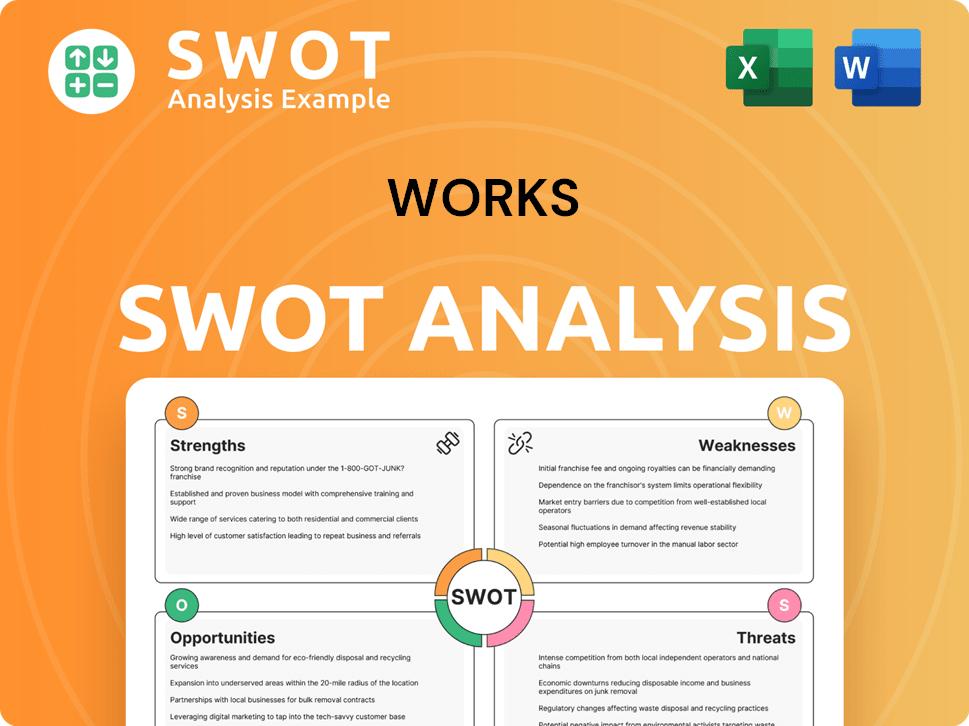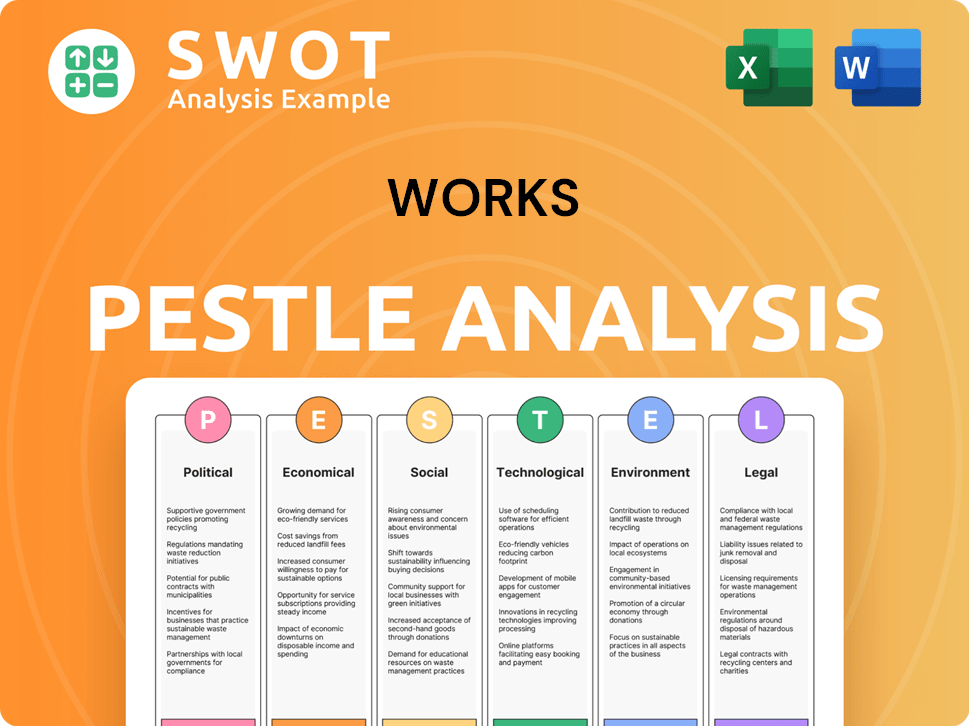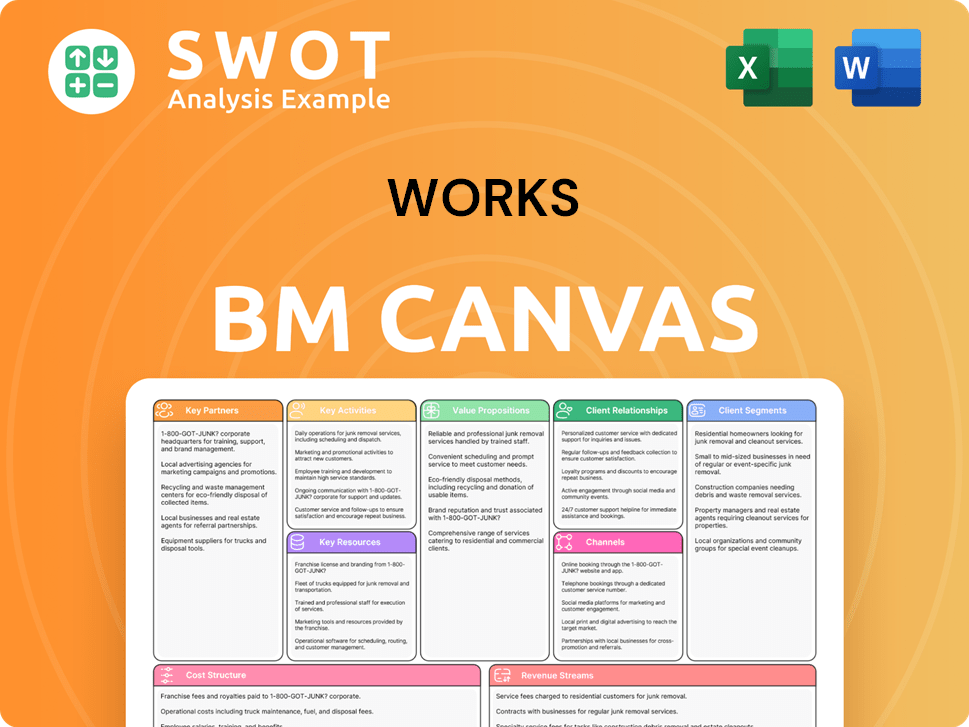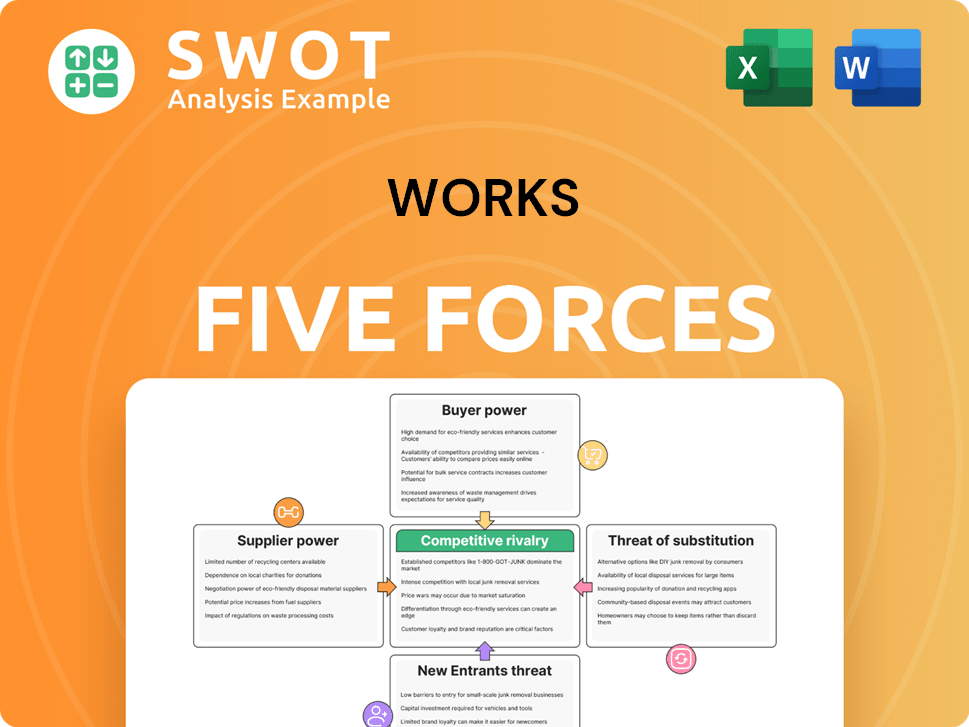Works Bundle
How Does The Works Company Thrive in the UK Retail Market?
The Works Company, a leading discount retailer, has masterfully navigated the ever-changing retail landscape through strategic sales and marketing initiatives. From its humble beginnings in 1981, the company has consistently adapted its approach to meet evolving consumer demands. This analysis delves into the core elements of The Works' Works SWOT Analysis, exploring its successful strategies.

This exploration will uncover the intricacies of The Works' sales and marketing strategies, examining how it has built a strong brand presence and driven sales growth. We'll dissect its go-to-market strategy, from its initial focus on physical stores to its current omnichannel approach, and analyze the effectiveness of its marketing campaigns. Understanding these aspects is crucial for anyone seeking insights into successful business strategy and market dynamics, including sales and marketing alignment.
How Does Works Reach Its Customers?
The Works Company employs a multifaceted sales strategy, utilizing both physical and digital channels to maximize market reach. This sales and marketing approach is crucial for engaging its diverse customer base effectively. The company's business strategy focuses on a balanced go-to-market strategy that leverages both traditional retail and modern e-commerce platforms.
The company's success is driven by its ability to adapt to changing consumer behaviors, as evidenced by its investment in digital channels. The Works Company has strategically integrated its online and offline presences to provide a seamless customer experience. This omnichannel approach allows customers to interact with the brand in multiple ways, enhancing convenience and satisfaction.
The company's primary offline sales channel is its network of physical retail stores across the UK. As of its latest reports, the company operates over 525 stores, providing tangible access to its product range. These stores are designed to offer in-person customer engagement, in-store promotions, and click-and-collect services. The company has been optimizing store layouts to improve customer flow and product discoverability.
The company's website, works.co.uk, serves as its primary online sales hub. It offers a comprehensive product catalog, exclusive deals, and various delivery options. The digital platform has been a significant driver of sales growth, especially during the pandemic.
Digital transactions contributed 33.7% of total sales in the 26 weeks ending October 29, 2023. Online sales growth often outpaces in-store like-for-like sales. This demonstrates a strong shift towards digital channels.
The company has integrated online browsing with in-store pickup options. This enhances convenience and customer satisfaction. This seamless transition between online and offline channels is a key part of the Works Company strategy.
The company continues to refine its value proposition and expand its digital presence. The focus remains on its proprietary platform, while exploring potential partnerships. The company is constantly evolving its sales strategy.
The company's sales channels are integral to its overall marketing strategy, supporting its brand positioning and customer acquisition efforts. For more insights into the company's broader strategic goals, including its mission and growth initiatives, consider reading about the Growth Strategy of Works.
The Works Company focuses on a balanced approach, combining physical stores with a strong e-commerce presence. This strategy allows the company to reach a wide audience. It is designed to maximize sales and customer engagement.
- Physical Retail: Over 525 stores across the UK provide in-person shopping and click-and-collect.
- E-commerce: The works.co.uk website offers a comprehensive online shopping experience.
- Omnichannel: Integration between online and offline channels enhances customer convenience.
- Digital Growth: Online sales contribute significantly to total revenue, with 33.7% of sales coming from digital channels in the latest reporting period.
Works SWOT Analysis
- Complete SWOT Breakdown
- Fully Customizable
- Editable in Excel & Word
- Professional Formatting
- Investor-Ready Format

What Marketing Tactics Does Works Use?
The Works Company employs a multifaceted marketing strategy, blending digital and traditional tactics to boost brand awareness, generate leads, and drive sales. Their approach is designed to engage customers and foster a strong community around their products. The company's success hinges on its ability to adapt and innovate within the ever-changing retail landscape.
The company's marketing efforts are data-driven, allowing for targeted campaigns and personalized customer experiences. This focus on data helps optimize marketing spend and improve customer lifetime value. The Works Company's marketing strategy is a dynamic process.
The company's marketing strategy is a dynamic process. The company uses a mix of digital and traditional marketing to reach its target audience. This includes content marketing, SEO, paid advertising, email marketing, and social media engagement. The company also participates in events and uses print advertising to reach its customers.
The Works Company heavily utilizes digital marketing channels, reflecting a shift in promotional spending towards online platforms. This includes content marketing, SEO, and paid advertising to reach a wide audience. Digital strategies are crucial for driving traffic and sales.
Content marketing is a core component, with regular updates to the website and blog featuring articles, guides, and creative ideas. This content aims to engage customers beyond transactions, fostering a community. This strategy helps build brand loyalty and drive organic traffic.
Search Engine Optimization (SEO) is crucial for driving organic traffic to its e-commerce platform, ensuring high visibility for popular product searches. Effective SEO improves online visibility and attracts potential customers. This is a key element of their Competitors Landscape of Works.
Paid advertising, including search engine marketing (SEM) and display ads, is strategically used to target specific demographics and promote seasonal offers or new product launches. This helps reach a broader audience and boost sales during key periods. Paid advertising is a key part of their marketing strategy.
Email marketing remains a core tactic for customer retention and repeat purchases, with personalized newsletters and promotional offers sent to segmented customer lists. Personalized emails can significantly increase customer engagement and drive sales. Email marketing is an important part of the sales and marketing strategy.
The Works Company leverages social media platforms like Facebook, Instagram, and TikTok to engage with its audience, showcase products, run contests, and amplify user-generated content. Social media helps build brand awareness and connect with customers. Social media marketing is vital for the company's success.
While digital marketing is emphasized, The Works may still use print advertising in relevant magazines or local newspapers. They also participate in events like craft fairs and book festivals to interact directly with customers and showcase their product range. These traditional methods complement their digital efforts.
- Print advertising may still be used in relevant magazines or local newspapers.
- Participation in craft fairs or book festivals provides direct customer interaction.
- These traditional methods complement digital strategies.
- The company's approach to data-driven marketing is evident.
Works PESTLE Analysis
- Covers All 6 PESTLE Categories
- No Research Needed – Save Hours of Work
- Built by Experts, Trusted by Consultants
- Instant Download, Ready to Use
- 100% Editable, Fully Customizable

How Is Works Positioned in the Market?
The Works positions itself as a leading discount retailer, focusing on exceptional value across a wide array of products. Its brand strategy centers on affordability and a broad product selection, aiming to make creativity, learning, and leisure accessible to everyone. The core message emphasizes 'amazing value' and 'something for everyone,' creating a strong brand identity.
The visual identity is bright and inviting, using vibrant colors and clear typography to convey fun and accessibility. The tone of voice is friendly and approachable, reflecting its family-friendly product range. The customer experience promises discovery and affordability, where customers can find unexpected treasures and everyday essentials without overspending. The company's approach is consistently communicated across all channels, from in-store displays to online promotions.
The Works's brand positioning is about offering high-quality products at significantly discounted prices, a unique selling proposition consistently communicated across all channels. This approach helps the company to remain relevant and attractive in a dynamic retail landscape. The company actively responds to shifts in consumer sentiment, adapting its product offerings to current trends and maintaining competitive pricing. For more information on their target audience, check out this article on the Target Market of Works.
The core message revolves around making creativity, learning, and leisure accessible to everyone. It emphasizes 'amazing value' and 'something for everyone' to resonate with a broad audience. This approach is central to the company's brand positioning and marketing strategy.
The visual identity is typically bright and inviting, often featuring vibrant colors and clear, easy-to-read typography. This design choice conveys a sense of fun and accessibility, making the brand appealing to a wide demographic. The consistent branding across all platforms reinforces the brand's identity.
The tone of voice is friendly, approachable, and enthusiastic, reflecting its family-friendly product range and customer-centric approach. This communication style builds trust and encourages customer loyalty. It supports the overall marketing strategy.
The customer experience promises discovery and affordability, where customers can find unexpected treasures and everyday essentials without breaking the bank. This experience drives repeat business. The company's sales and marketing efforts are aligned to deliver this experience.
Works Business Model Canvas
- Complete 9-Block Business Model Canvas
- Effortlessly Communicate Your Business Strategy
- Investor-Ready BMC Format
- 100% Editable and Customizable
- Clear and Structured Layout

What Are Works’s Most Notable Campaigns?
The Growth Strategy of Works involves a dynamic interplay of sales and marketing initiatives. Their sales strategy and marketing strategy are designed to drive customer engagement and boost sales. The company's approach to its business strategy is heavily influenced by seasonal events and promotional offers, focusing on value and affordability to attract a broad customer base.
Key campaigns for the Works Company are centered around seasonal events and specific product categories. These campaigns are designed to boost sales during peak trading periods and highlight the value proposition. The company employs multi-channel strategies, including in-store displays, website promotions, and email marketing, to maximize reach and impact.
A significant component of the Works Company's sales and marketing strategy involves promoting key product categories, such as books or art supplies, often with offers like '3 for £5' or '2 for £10'. These campaigns encourage bulk purchases and highlight savings, primarily through in-store merchandising, website banners, and targeted emails. Success is measured by increased category sales and overall transaction volume.
The company often runs seasonal campaigns to capitalize on peak shopping periods like Christmas and Easter. These promotions are designed to drive foot traffic and online sales. They frequently include themed product displays and special offers.
The Works Company emphasizes everyday low prices across its product range. This is a core element of its brand identity. These campaigns highlight affordability and value, attracting budget-conscious consumers.
Promotions like '3 for £5' on books or '2 for £10' on art supplies drive bulk purchases. These campaigns are crucial for boosting sales in key product areas. They use in-store displays, website banners, and email marketing.
The company utilizes digital channels to boost visibility and sales. This includes website promotions, email marketing to subscribers, and social media engagement. These efforts help reach a wider audience.
Collaborations with craft bloggers, educational content creators, or parenting influencers could enhance brand visibility. These partnerships are particularly effective for product launches and seasonal promotions. This strategy aligns with current market trends.
- Partnerships with relevant influencers can improve brand credibility and reach.
- Influencers can create content showcasing products, driving engagement and sales.
- This approach can be particularly effective for new product launches and seasonal campaigns.
- Influencer marketing helps to target specific customer segments effectively.
Works Porter's Five Forces Analysis
- Covers All 5 Competitive Forces in Detail
- Structured for Consultants, Students, and Founders
- 100% Editable in Microsoft Word & Excel
- Instant Digital Download – Use Immediately
- Compatible with Mac & PC – Fully Unlocked

Related Blogs
- What are Mission Vision & Core Values of Works Company?
- What is Competitive Landscape of Works Company?
- What is Growth Strategy and Future Prospects of Works Company?
- How Does Works Company Work?
- What is Brief History of Works Company?
- Who Owns Works Company?
- What is Customer Demographics and Target Market of Works Company?
Disclaimer
All information, articles, and product details provided on this website are for general informational and educational purposes only. We do not claim any ownership over, nor do we intend to infringe upon, any trademarks, copyrights, logos, brand names, or other intellectual property mentioned or depicted on this site. Such intellectual property remains the property of its respective owners, and any references here are made solely for identification or informational purposes, without implying any affiliation, endorsement, or partnership.
We make no representations or warranties, express or implied, regarding the accuracy, completeness, or suitability of any content or products presented. Nothing on this website should be construed as legal, tax, investment, financial, medical, or other professional advice. In addition, no part of this site—including articles or product references—constitutes a solicitation, recommendation, endorsement, advertisement, or offer to buy or sell any securities, franchises, or other financial instruments, particularly in jurisdictions where such activity would be unlawful.
All content is of a general nature and may not address the specific circumstances of any individual or entity. It is not a substitute for professional advice or services. Any actions you take based on the information provided here are strictly at your own risk. You accept full responsibility for any decisions or outcomes arising from your use of this website and agree to release us from any liability in connection with your use of, or reliance upon, the content or products found herein.